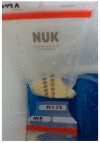High-Pressure Inactivation of Bacillus cereus in Human Breast Milk
- PMID: 38231674
- PMCID: PMC10706202
- DOI: 10.3390/foods12234245
High-Pressure Inactivation of Bacillus cereus in Human Breast Milk
Abstract
Although Holder pasteurization is the recommended method for processing breast milk, it does affect some of its nutritional and biological properties and is ineffective at inactivating spores. The aim of this study was to find and validate an alternative methodology for processing breast milk to increase its availability for newborn babies and reduce the financial loss associated with discarding milk that has become microbiologically positive. We prepared two series of breast milk samples inoculated with the Bacillus cereus (B. cereus) strain to verify the effectiveness of two high-pressure treatments: (1) 350 MPa/5 min/38 °C in four cycles and (2) cumulative pressure of 350 MPa/20 min/38 °C. We found that the use of pressure in cycles was statistically more effective than cumulative pressure. It reduced the number of spores by three to four orders of magnitude. We verified that the method was reproducible. The routine use of this method could lead to an increased availability of milk for newborn babies, and at the same time, reduce the amount of wasted milk. In addition, high-pressure treatment preserves the nutritional quality of milk.
Keywords: Bacillus cereus; human breast milk; inoculation; pressurization.
Conflict of interest statement
We confirm that this work is original and has not been published elsewhere, nor is it currently under consideration for publication elsewhere. We have no conflict of interest to disclose.
Figures










Similar articles
-
Inactivation of Bacillus cereus spores in milk by mild pressure and heat treatments.Int J Food Microbiol. 2004 Apr 15;92(2):227-34. doi: 10.1016/j.ijfoodmicro.2003.09.011. Int J Food Microbiol. 2004. PMID: 15109800
-
High Hydrostatic Pressure Treatment Ensures the Microbiological Safety of Human Milk Including Bacillus cereus and Preservation of Bioactive Proteins Including Lipase and Immuno-Proteins: A Narrative Review.Foods. 2021 Jun 9;10(6):1327. doi: 10.3390/foods10061327. Foods. 2021. PMID: 34207614 Free PMC article. Review.
-
Influence of several environmental factors on the initiation of germination and inactivation of Bacillus cereus by high hydrostatic pressure.Int J Food Microbiol. 1998 Oct 20;44(1-2):125-32. doi: 10.1016/s0168-1605(98)00130-5. Int J Food Microbiol. 1998. PMID: 9849790
-
The combined effects of high pressure and nisin on germination and inactivation of Bacillus spores in milk.J Appl Microbiol. 2008 Jul;105(1):78-87. doi: 10.1111/j.1365-2672.2007.03722.x. Epub 2008 Jan 31. J Appl Microbiol. 2008. PMID: 18248377
-
Innovative Techniques of Processing Human Milk to Preserve Key Components.Nutrients. 2019 May 24;11(5):1169. doi: 10.3390/nu11051169. Nutrients. 2019. PMID: 31137691 Free PMC article. Review.
References
-
- Demazeau G., Plumecocq A., Lehours P., Martin P., Couëdelo L., Billeaud C. A New High Hydrostatic Pressure Process to Assure the Microbial Safety of Human Milk While Preserving the Biological Activity of Its Main Components. Front. Public Health. 2018;6:306. doi: 10.3389/fpubh.2018.00306. - DOI - PMC - PubMed
-
- Decousser J.-W., Ramarao N., Duport C., Dorval M., Bourgeois-Nicolaos N., Guinebretière M.-H., Razafimahefa H., Doucet-Populaire F. Bacillus Cereus and Severe Intestinal Infections in Preterm Neonates: Putative Role of Pooled Breast Milk. Am. J. Infect. Control. 2013;41:918–921. doi: 10.1016/j.ajic.2013.01.043. - DOI - PubMed
Grants and funding
LinkOut - more resources
Full Text Sources
Molecular Biology Databases

